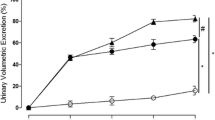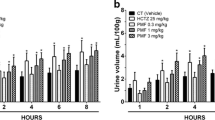Abstract
Although present in the leaves of Mimosa bimucronata (DC.) and many other medicinal plants commonly used to augment urinary volume excretion, the effects of gallic acid as a diuretic agent remain to be studied. Wistar rats were orally treated with vehicle, hydrochlorothiazide, or gallic acid. The effects of gallic acid in the presence of hydrochlorothiazide, furosemide, amiloride, L-NAME, atropine, and indomethacin were also investigated. Diuretic index, pH, conductivity, and electrolyte excretion were evaluated at the end of the experiment (after 8 or 24 h). Gallic acid induced diuretic and saluretic (Na+ and Cl−) effects, without interfering with K+ excretion, when orally given to female and male rats at a dose of 3 mg/kg. These effects were associated with increased creatinine and conductivity values while pH was unaffected by any of the treatments. Plasma Na+, K+, and Cl− levels were not affected by any of the acute treatments. The combination with hydrochlorothiazide or furosemide was unable to intensify the effects of gallic acid when compared with the response obtained with each drug alone. On the other hand, the treatment with amiloride plus gallic acid amplified both diuresis and saluresis, besides to a marked potassium-sparing effect. Its diuretic action was significantly prevented in the presence of indomethacin, a cyclooxygenase inhibitor, but not with the pretreatments with L-NAME or atropine. Although several biological activities have already been described for gallic acid, this is the first study demonstrating its potential as a diuretic agent.



Similar content being viewed by others
References
Ajibade TO, Oyagbemi AA, Omobowale TO, Asenuga ER, Afolabi JM, Adedapo AA (2016) Mitigation of diazinon-induced cardiovascular and renal dysfunction by gallic acid. Interdiscip Toxicol 9(2):66–77
Blanco VZ, Auw JM, Sims CA, O'Keefe SF (1998) Effect of processing on phenolics of wines. Adv Exp Med Biol 434:327–340
Boeing T, da Silva LM, Mariott M, Andrade SF, de Souza P (2017) Diuretic and natriuretic effect of luteolin in normotensive and hypertensive rats: Role of muscarinic acetylcholine receptors. Pharmacol Rep 69(6):1121–1124
de Berrazueta JR, González JP, de Mier I, Poveda JJ, García-Unzueta MT (2007) Vasodilatory action of loop diuretics: a plethysmography study of endothelial function in forearm arteries and dorsal hand veins in hypertensive patients and controls. J Cardiovasc Pharmacol 49(2):90–95
de Oliveira LM, de Oliveira TS, da Costa RM, de Souza Gil E, Costa EA, Passaglia R de C, Filgueira FP, Ghedini PC (2016) The vasorelaxant effect of gallic acid involves endothelium-dependent and -independent mechanisms. Vasc Pharmacol 81:69–74
De Souza P, Crestani S, da Silva Rde C, Gasparotto F, Kassuya CA, da Silva-Santos JE, Gasparotto A Jr (2013) Involvement of bradykinin and prostaglandins in the diuretic effects of Achillea millefolium L. (Asteraceae). J Ethnopharmacol 149(1):157–161
De Souza P, Boeing T, Somensi LB, Cechinel-Zanchett CC, Bastos JK, Petreanu M, Niero R, Cechinel-Filho V, Da Silva LM, De Andrade SF (2017a) Diuretic effect of extracts, fractions and two compounds 2α,3β,19α-trihydroxy-urs-12-en-28-oicacid and 5-hydroxy-3,6,7,8,4′-pentamethoxyflavone from Rubus rosaefolius Sm. (Rosaceae) leaves in rats. Naunyn Schmiedeberg's Arch Pharmacol 390(4):351–360
De Souza P, da Silva LM, Boeing T, Somensi LB, Cechinel-Zanchett CC, Campos A, Krueger CMA, Bastos JK, Cechinel-Filho V, Andrade SF (2017b) Influence of Prostanoids in the Diuretic and Natriuretic Effects of Extracts and Kaempferitrin from Bauhinia forficata Link Leaves in Rats. Phytother Res 31(10):1521–1528
Ferrari P, Frey FJ (2000) Pharmacologic action of diuretics in the kidney. Ther Umsch 57(6):345–350
Gasparotto Junior A, Prando TB, Leme Tdos S, Gasparotto FM, Lourenço EL, Rattmann YD, Da Silva-Santos JE, Kassuya CA, Marques MC (2012) Mechanisms underlying the diuretic effects of Tropaeolum majus L. extracts and its main component isoquercitrin. J Ethnopharmacol 141(1):501–509
Govea-Salas M, Rivas-Estilla AM, Rodríguez-Herrera R, Lozano-Sepúlveda SA, Aguilar-Gonzalez CN, Zugasti-Cruz A, Salas-Villalobos TB, Morlett-Chávez JA (2016) Gallic acid decreases hepatitis C virus expression through its antioxidant capacity. Exp Ther Med 11(2):619–624
Greenberg S, McGowan C, Xie J, Summer WR (1994) Selective pulmonary and venous smooth muscle relaxation by furosemide: a comparison with morphine. J Pharmacol Exp Ther 270:1077–1085
Huang DW, Chang WC, Wu JS, Shih RW, Shen SC (2016) Gallic acid ameliorates hyperglycemia and improves hepatic carbohydrate metabolism in rats fed a high-fructose diet. Nutr Res 36(2):150–160
Jin L, Lin MQ, Piao ZH, Cho JY, Kim GR, Choi SY, Ryu Y, Sun S, Kee HJ, Jeong MH (2017) Gallic acid attenuates hypertension, cardiac remodeling, and fibrosis in mice with NG-nitro-L-arginine methyl ester-induced hypertension via regulation of histone deacetylase 1 or histone deacetylase 2. J Hypertens 35(7):1502–1512
Kang N, Lee JH, Lee W, Ko JY, Kim EA, Kim JS, Heu MS, Kim GH, Jeon YJ (2015) Gallic acid isolated from Spirogyra sp. improves cardiovascular disease through a vasorelaxant and antihypertensive effect. Environ Toxicol Pharmacol 39(2):764–772
Legroux-Gerot I, Catanzariti L, Marchandise X, Duquesnoy B, Cortet B (2004) Bone mineral density changes in hypercalciuretic osteoporotic men treated with thiazide diuretics. Joint Bone Spine 71:51–55
Lin WH, Kuo HH, Ho LH, Tseng ML, Siao AC, Hung CT, Jeng KC, Hou CW (2015) Gardenia jasminoides extracts and gallic acid inhibit lipopolysaccharide-induced inflammation by suppression of JNK2/1 signaling pathways in BV-2 cells. Iran J Basic Med Sci 18(6):555–562
Omobowale TO, Oyagbemi AA, Ajufo UE, Adejumobi OA, Ola-Davies OE, Adedapo AA, Yakubu MA (2017) Ameliorative effect of Gallic acid in doxorubicin-induced hepatotoxicity in Wistar rats through antioxidant defense system. J Diet Suppl 18:1–14
Ow YY, Stupans I (2003) Gallic acid and gallic acid derivatives: effects on drug metabolizing enzymes. Curr Drug Metab 4(3):241–248
Phonsatta N, Deetae P, Luangpituksa P, Grajeda-Iglesias C, Figueroa-Espinoza MC, Le Comte J, Villeneuve P, Decker EA, Visessanguan W, Panya A (2017) Comparison of antioxidant evaluation assays for investigating Antioxidative activity of Gallic acid and its alkyl esters in different food matrices. J Agric Food Chem 65(34):7509–7518
Pickkers P, Hughes AD, Russel FG, Thien T, Smits P (1998) Thiazide-induced vasodilation in humans is mediated by potassium channel activation. Hypertension 32(6):1071–1076
Plant L (2003) Clinical use of diuretics. Clin Med 3:517–520
Qavi AH, Kamal R, Schrier RW (2015) Clinical Use of Diuretics in Heart Failure, Cirrhosis, and Nephrotic Syndrome. Int J Nephrol Article ID 975934, 9 pages
Raftery EB (1994) Hemodynamic effects of diuretics in heart failure. Br Heart J 72(suppl 2):44–7S
Rose BD (1991) Diuretics. Kidney Int 39(2):336–352
Sarafidis PA, Georgianos PI, Lasaridis AN (2010a) Diuretics in clinical practice. Part II: electrolyte and acid-base disorders complicating diuretic therapy. Expert Opin Drug Saf 9:259–273
Sarafidis PA, Georgianos PI, Lasaridis AN (2010b) Diuretics in clinical practice. Part I: mechanisms of action, pharmacological effects and clinical indications of diuretic compounds. Expert Opin Drug Saf 9:243–257
Schlickmann F, de Souza P, Boeing T, Mariano LNB, Steimbach VMB, Krueger CMA, da Silva LM, de Andrade SF, Cechinel-Filho V (2017) Chemical composition and diuretic, natriuretic and kaliuretic effects of extracts of Mimosa bimucronata (DC.) Kuntze leaves and its majority constituent methyl gallate in rats. J Pharm Pharmacol 69(11):1615–1624
Silke B (1994) Hemodynamic impact of diuretic therapy in chronic heart failure. Cardiology 84:115–123
Singh P, Knoedler JJ, Krambeck AE, Lieske JC, Bergstralh EJ, Rule AD (2014) Thiazide diuretic prophylaxis for kidney stones and the risk of diabetes mellitus. J Urol 192(6):1700–1704
Subramanian AP, Jaganathan SK, Mandal M, Supriyanto E, Muhamad II (2016) Gallic acid induced apoptotic events in HCT-15 colon cancer cells. World J Gastroenterol 22(15):3952–3961
Umadevi S, Gopi V, Simna SP, Parthasarathy A, Yousuf SM, Elangovan V (2012) Studies on the cardioprotective role of gallic acid against AGE-induced cell proliferation and oxidative stress in H9C2 (2-1) cells. Cardiovasc Toxicol 12(4):304–311
Umadevi S, Gopi V, Elangovan V (2014) Regulatory mechanism of gallic acid against advanced glycation end products induced cardiac remodeling in experimental rats. Chem Biol Interact 208:28–36
Wargo KA, Banta WM (2009) A comprehensive review of the loop diuretics: should furosemide be first line? Ann Pharmacother 43(11):1836–1847
Wiemer G, Fink E, Linz W, Hropot M, Schölkens BE, Wohlfart P (1994) Furosemide enhances the release of endothelial kinins, nitric oxide and prostacyclin. J Pharmacol Exp Ther 271:1611–1615
Acknowledgements
This study was supported by Coordenação de Aperfeiçoamento de Pessoal de Nível Superior (CAPES), Conselho Nacional de Desenvolvimento Científico e Tecnológico (CNPq), and Universidade do Vale do Itajaí (UNIVALI). Dr. Rita de Cássia Melo Vilhena de Andrade Fonseca da Silva is grateful for the Postdoctoral scholarship from PNPD/CAPES.
Author information
Authors and Affiliations
Corresponding author
Ethics declarations
All the protocols described here were submitted and approved by institutional ethics committee from UNIVALI (license no. 045/16) and were performed following all the international standards and ethical guidelines on animal welfare.
Rights and permissions
About this article
Cite this article
Schlickmann, F., Boeing, T., Mariano, L.N.B. et al. Gallic acid, a phenolic compound isolated from Mimosa bimucronata (DC.) Kuntze leaves, induces diuresis and saluresis in rats. Naunyn-Schmiedeberg's Arch Pharmacol 391, 649–655 (2018). https://doi.org/10.1007/s00210-018-1502-8
Received:
Accepted:
Published:
Issue Date:
DOI: https://doi.org/10.1007/s00210-018-1502-8




